Saturn, Saint Gaudens & The Tom Seaver Era New York Mets
 TomB
Posts: 22,341 ✭✭✭✭✭
TomB
Posts: 22,341 ✭✭✭✭✭
This article is posted on my website under the "Blog & Articles" header, but I don't think my site generates that much reading traffic so I am sharing it here, too (in other words, no one reads the blog or articles on my site). However, I believe it is much easier to read and much easier on the eyes on my site.
I live close enough to the Saint Gaudens National Historic Site (SGNHS) such that my wife and I have visited several dozen times over the years and we have brought our daughters there numerous times, too. In general, we drive out to the SGHNS at least twice and up to four times during the year.
The site is in Cornish, NH, right along the Maxfield Parish Highway and has only a small sign at the beginning of the 0.6 mile long driveway. The driveway is fairly steep throughout and I imagine that 100+ years ago when the grounds were first built out that it was truly a bear to transport anything up the mountain. The tiny 24-spot parking lot has never been filled during one of our visits and this last weekend ours was the eighth car in the lot when we arrived around noon after a short walking tour of Dartmouth College. Admission to the park has increased in the last year, but at $7.00 per adult and no charge for children it is still a bargain. We have been there so often that we know all the Park Rangers by face as they do us, too, and the Park Ranger on duty gave me a friendly wave and asked if we were there to attend the star party that night. The star party was the precise reason why we were at the park that day and I will write about it shortly.
Across the private drive from the parking lot there is a sign to announce your arrival to the site. Behind this is a circular hedge with steps and directly behind the hedge is the house, which was named Aspet by Augustus Saint Gaudens. Aspet is the name of the town in France where Saint Gaudens father had been born. Next to the house is the studio. Neither is an enormous construction and the studio is likely just a tiny bit smaller than the home. We walked into the studio since the house is meant for guided tours while the studio allows a free flowing walk where you can actually get up next to the artwork and be as close as you like.
If one goes through the hedge and slightly to the left (west) then the views would include the Temple to the northwest, the Little Studio to the north and the home (Aspet) to the northeast. To the southwest is Mount Ascutney.
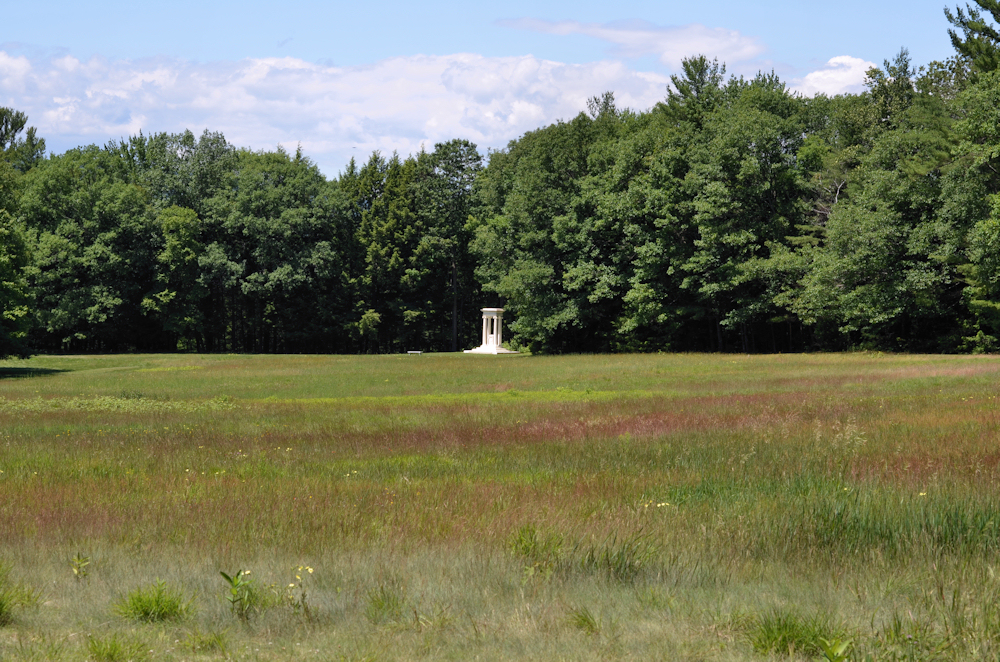
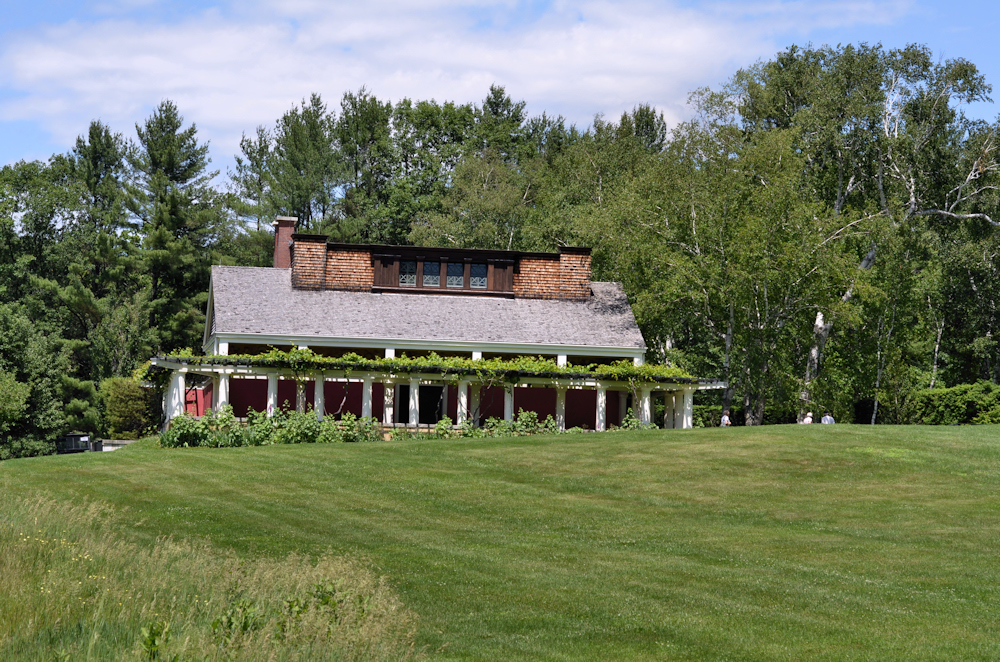
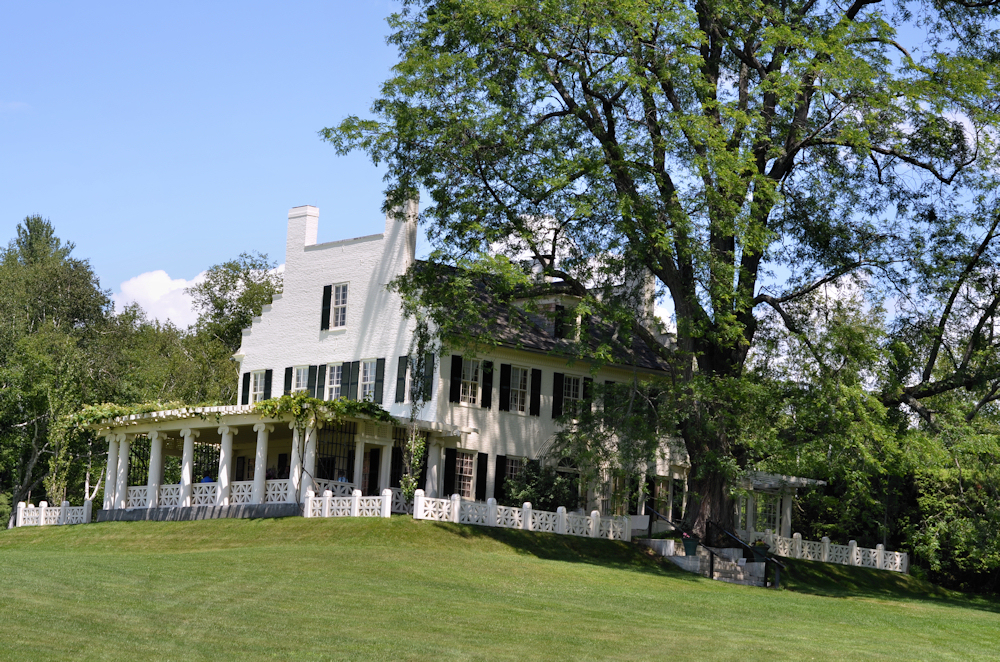
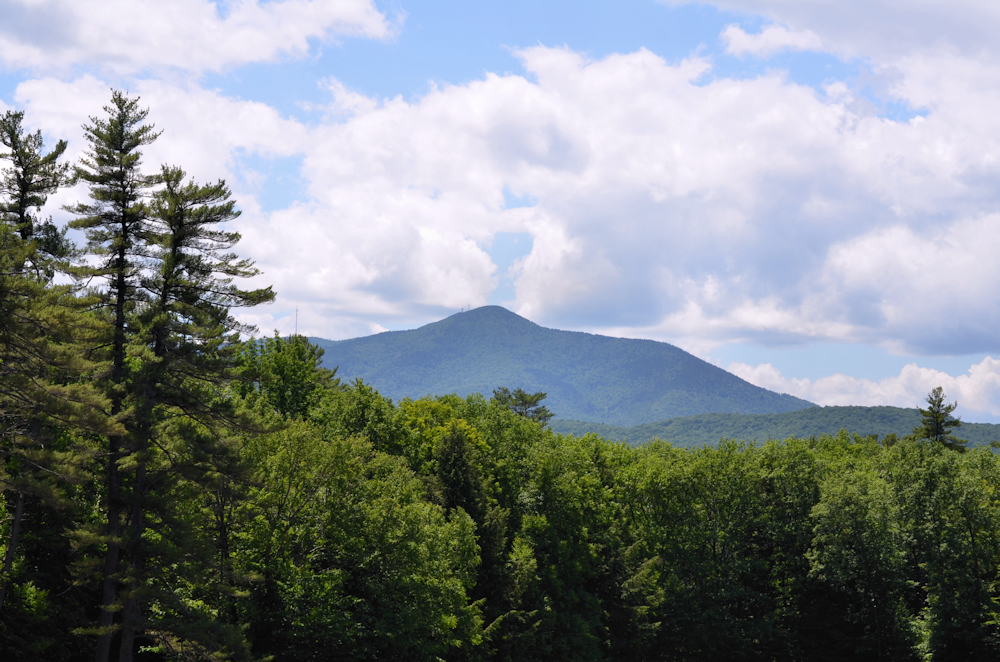
We ate our lunch on the porch of Aspet before exploring the grounds. What look like grape vines along the top of the porch on Aspet and along the veranda of the Little Studio are, indeed, grape vines and at this time of the year they have large, dark purple grapes. Inside the studio, Diana dominates the central working area. The top of her head stands perhaps ten feet off the ground and several images are included to give a sense of the room and the materials in the room. Diana was the only nude female sculpture that Saint Gaudens produced and it was originally placed at the top of Madison Square Garden in New York City. While there, it was gilded, lit up at night and continuously rotated. The model whose face was used for Diana was also used for Amor Caritas.
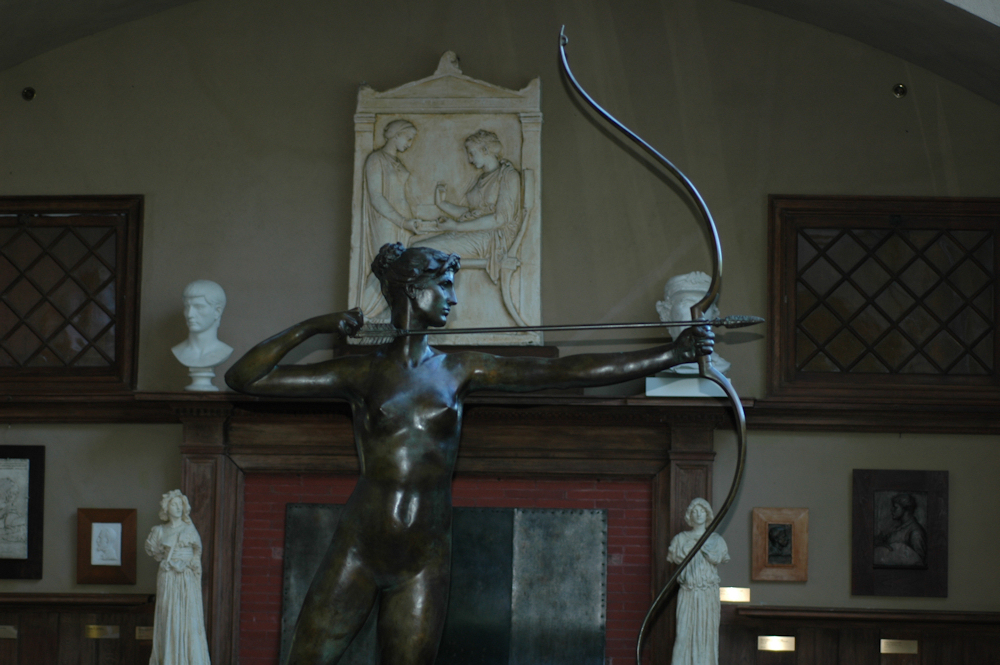
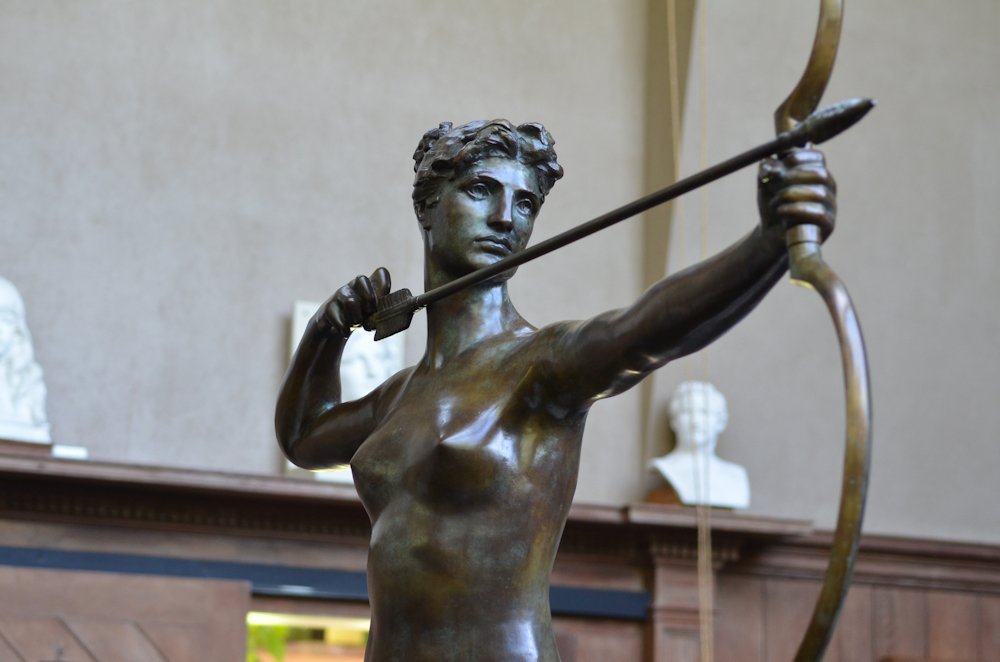
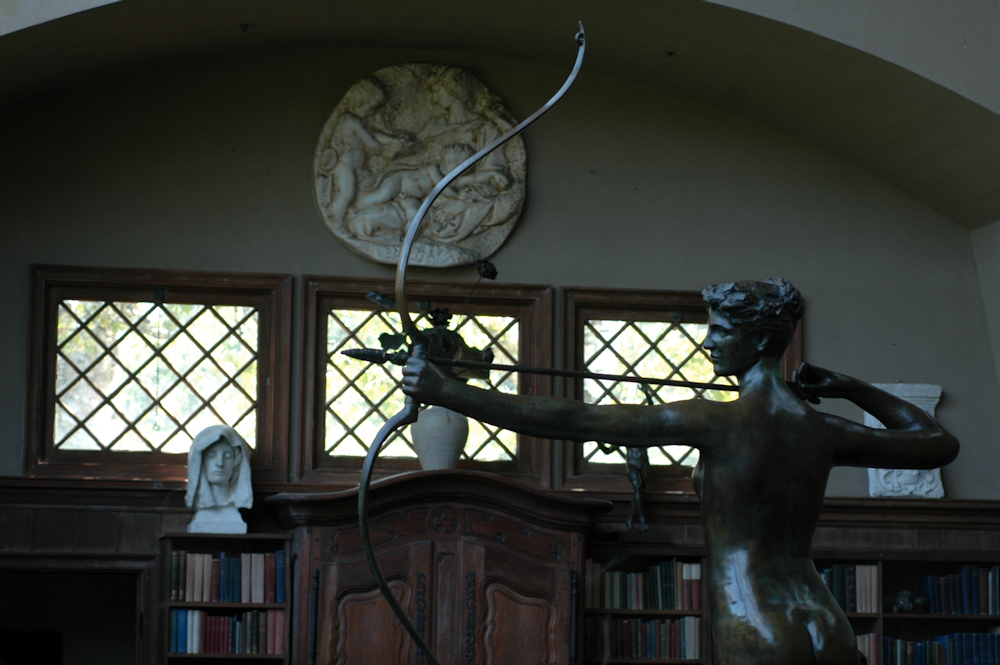
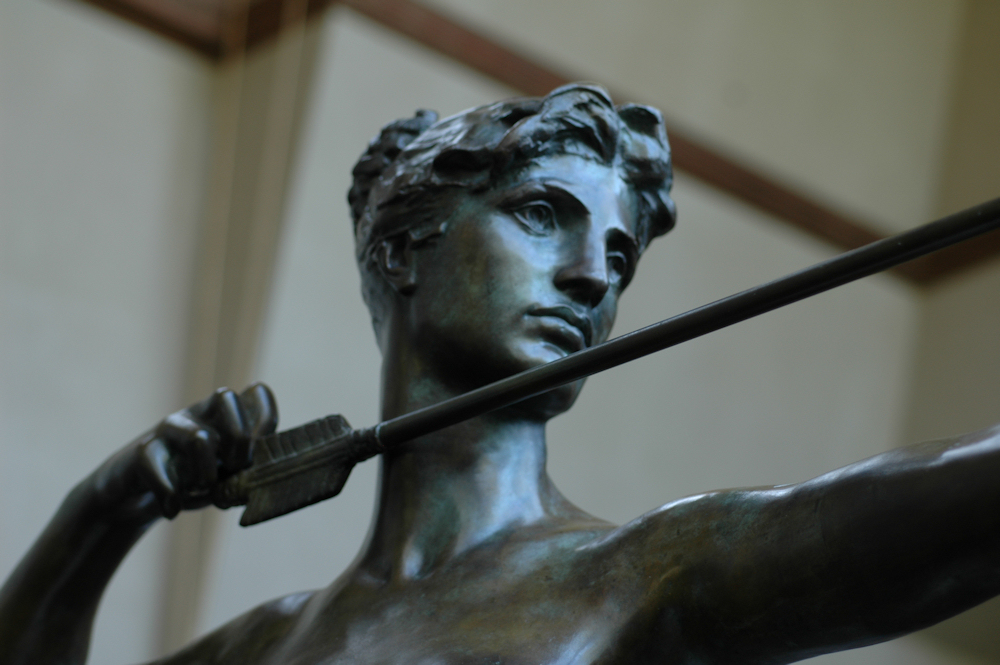
The studio is flooded with natural light as well as being filled with various works of art. These include a plaque that describes the little temple behind the studio and a special award presented to Saint Gaudens at the Pan American Exposition in 1901, which was created by Saint Gaudens’ former student, James Earle Fraser. Both the plaque and the award are about four feet in their longest dimension. Just around the corner is a tiny extra room that had been the gift shop in the 1990s, but is now a display of additional works of art. This is the only part of the studio that is roped off and, although I managed to set off the alarm system when I leaned over to take an image once, I did not do so on this trip. However, the Rangers ignored the alarm and, when I later told one that I inadvertently set it off; they told me it happens to them, too. These images show some of the work on display in this tiny area including a work featuring Lincoln, the head of the horse from the Sherman Memorial and a double eagle study with its negative.
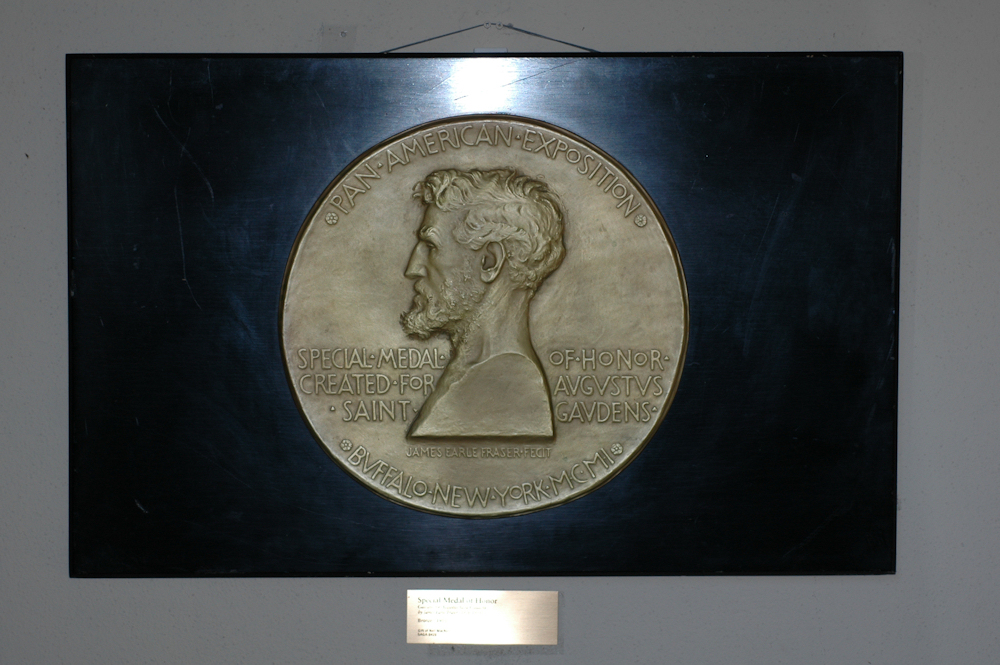
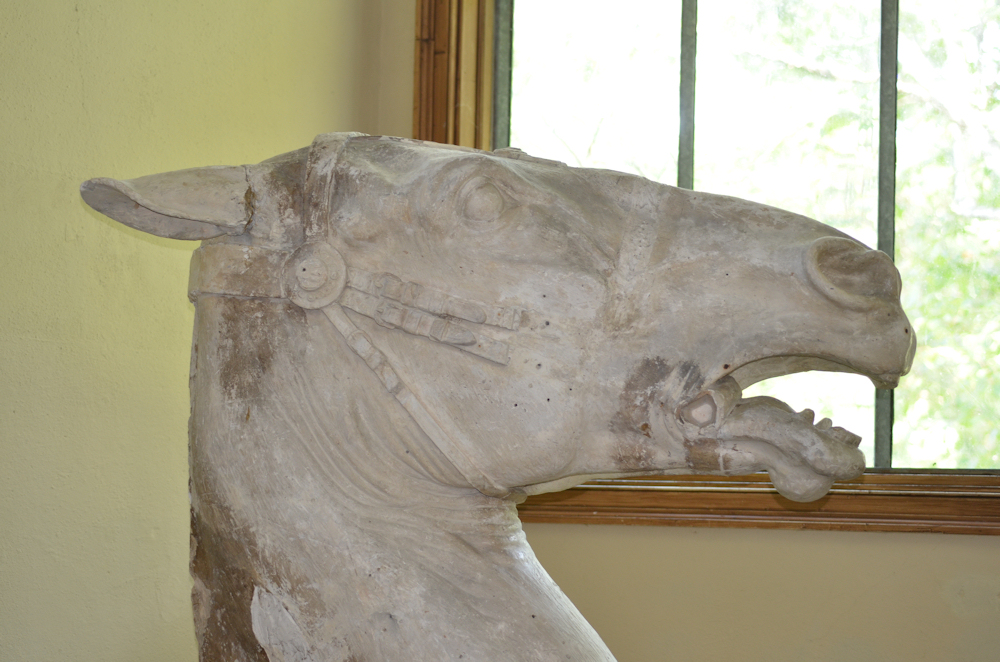
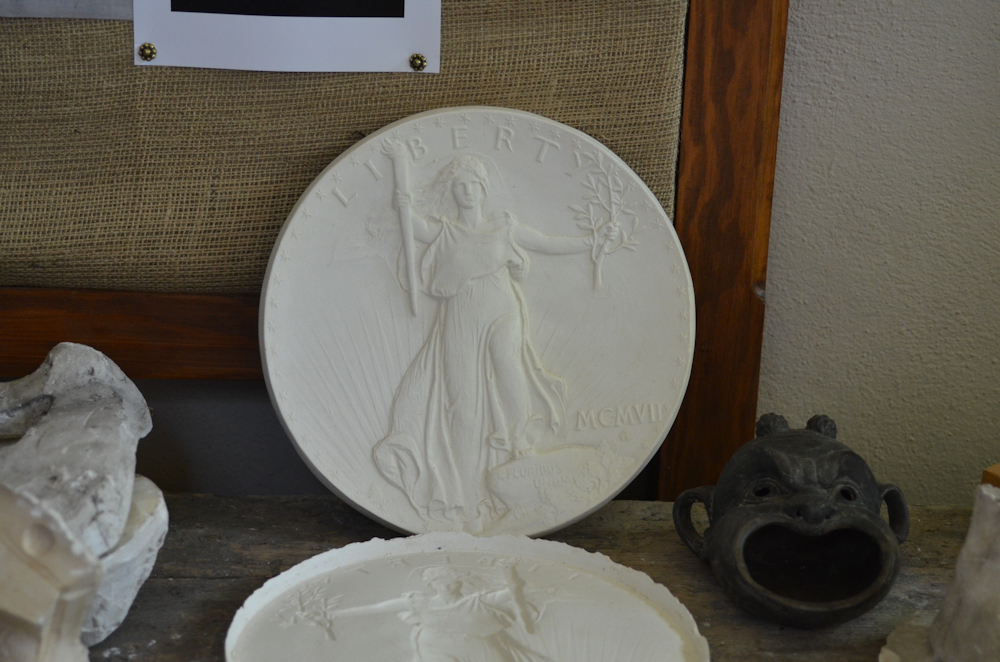
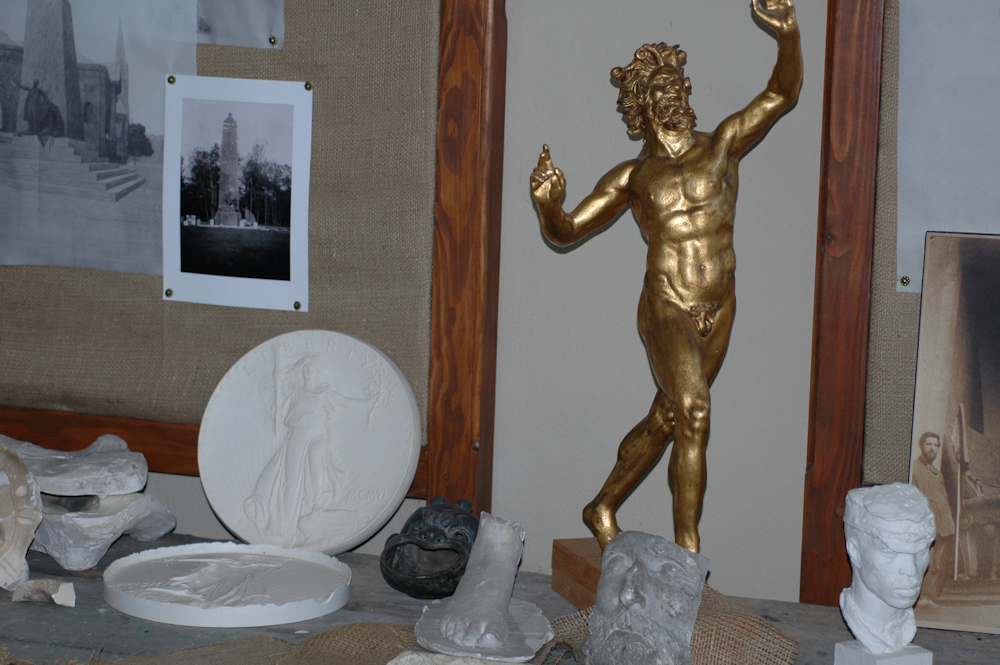
As soon as one exits the studio there are a series of small gardens that have statues and pools. These images show some of the works of art as well as the fish in the marble pool of the Pan Garden. Just past this garden there is a small wooded area with the Adams Memorial. This stands about seven feet high.
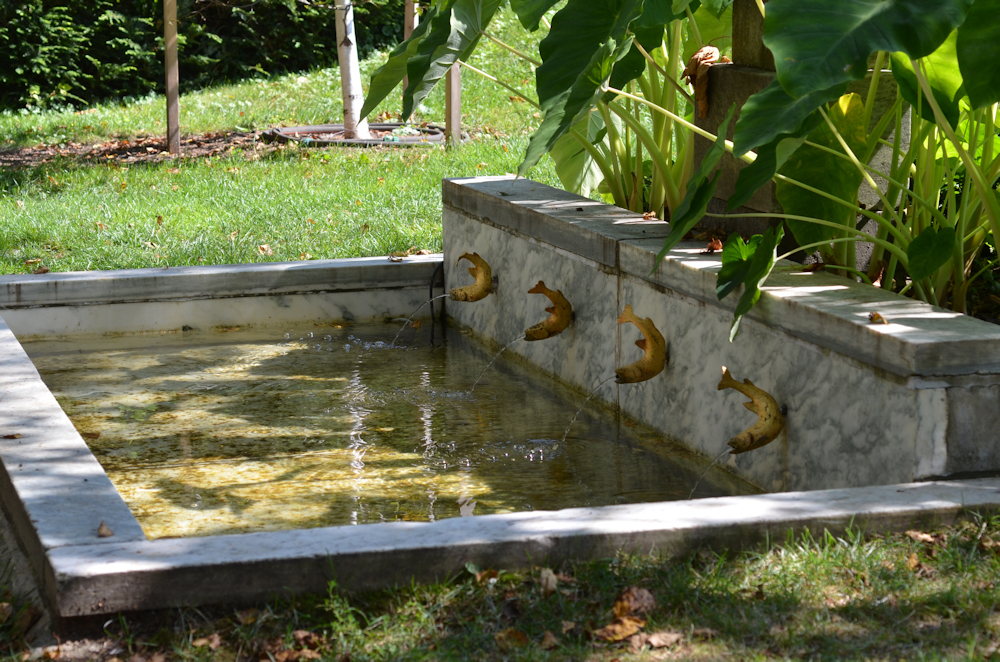
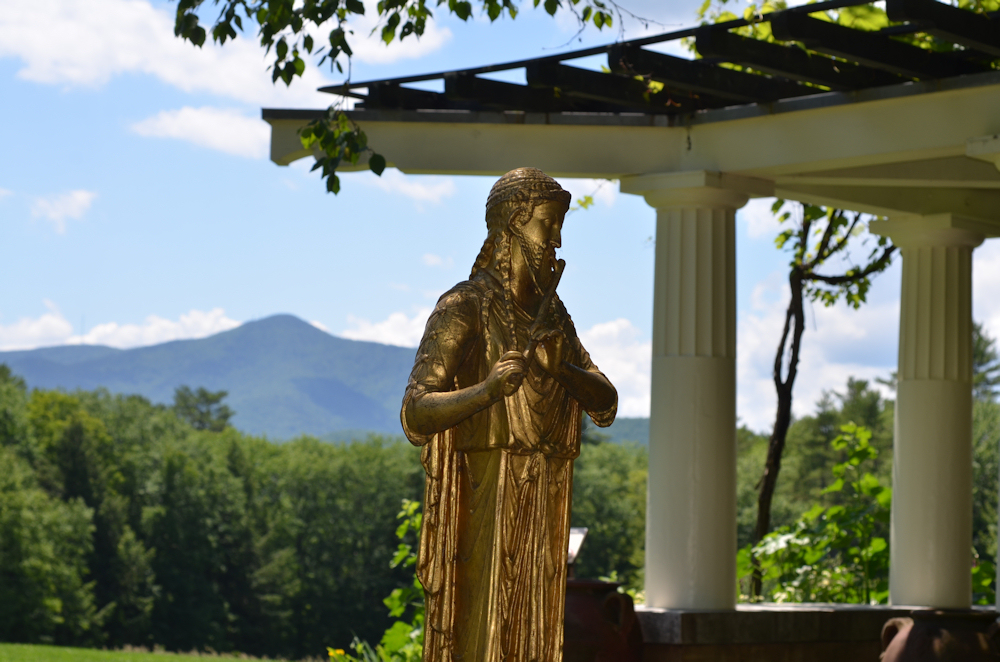
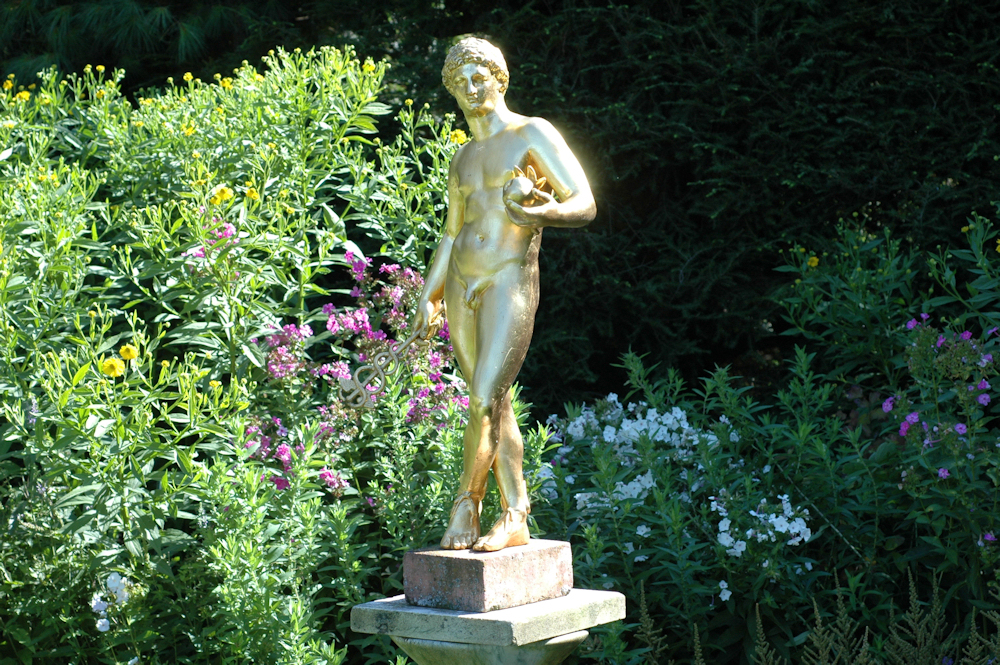
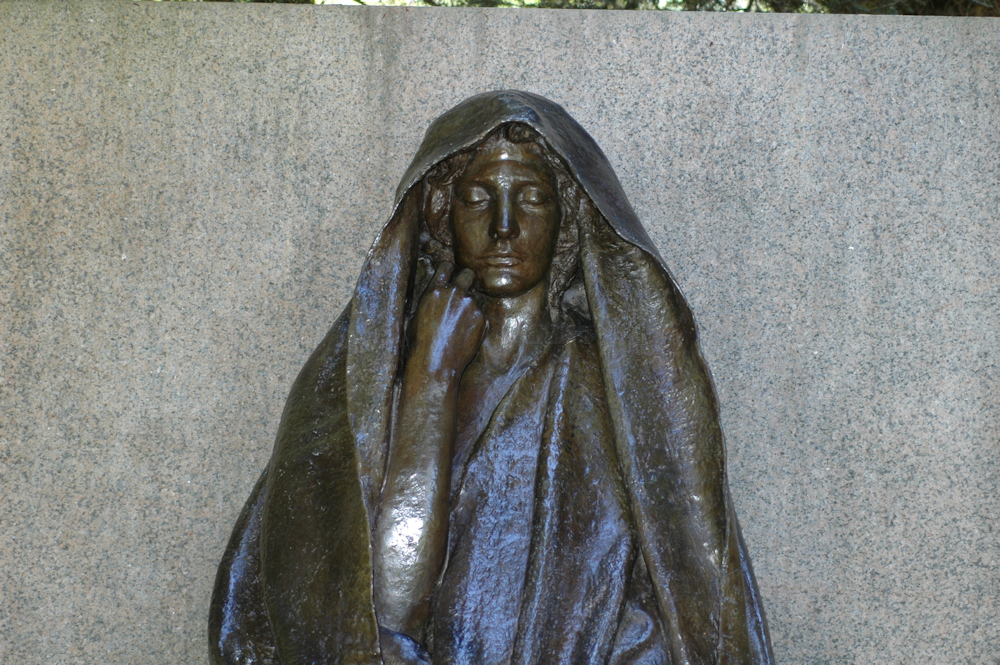
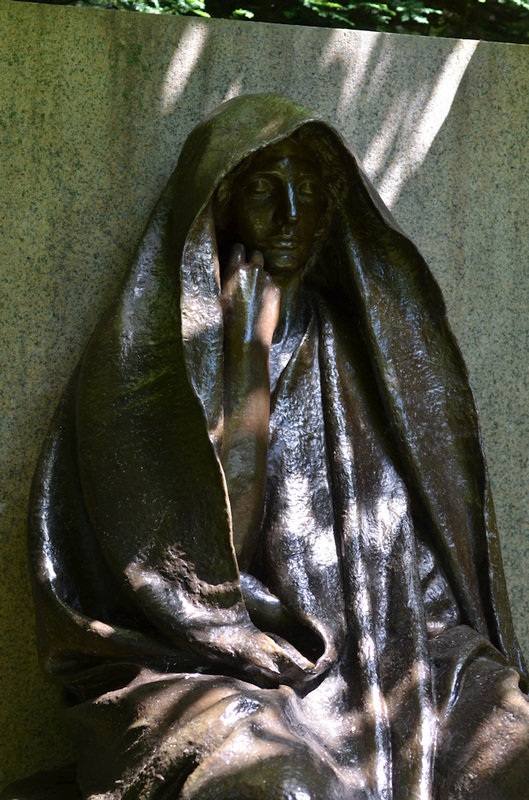
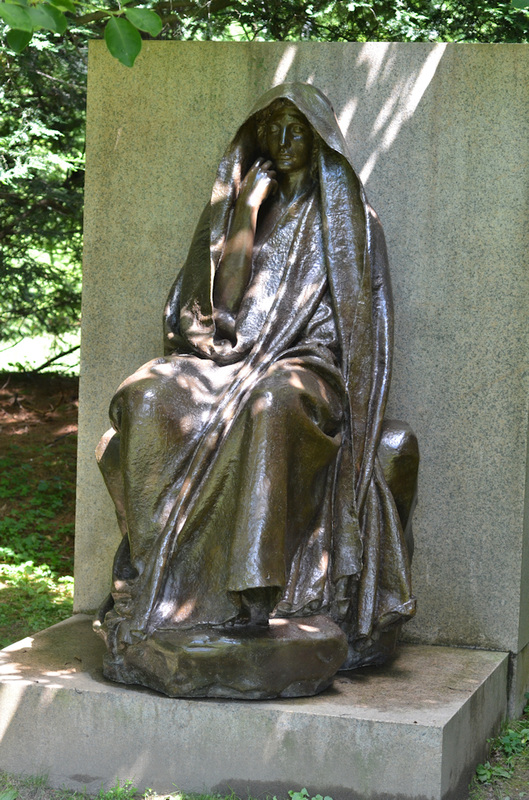
Many people consider the Adams Memorial to be one of the pinnacle examples of the work of Saint Gaudens. This monument had been commissioned after the suicide of Marian Adams and, truly, I have always found this work to be somewhat disturbing. Others have described it as incredibly contemplative, spiritual or soothing, but my thoughts always run toward the idea that I am interrupting something and have invaded personal space. Indeed, this monument is set away from all the others in its own small hedge enclosure. I never feel at ease when I am in there.
Just a few feet away is a narrow, but much larger hedge enclosed area for the Shaw Memorial. I’ve included four images of the memorial to give a sense of depth and well as an idea about how much detail is present in the work. It is approximately four feet deep. Robert Gould Shaw was the leader of the Fifty-Fourth Massachusetts Regiment, which was the first all-African American volunteer regiment. Saint Gaudens had initially proposed having Shaw as the major character of the memorial with the other soldiers far in the background, but Shaw’s family requested that the rest of the soldiers be given the care and respect that Shaw was to receive. The 1989 film “Glory” was based upon this unit, which was annihilated during the Second Battle of Fort Wagner.
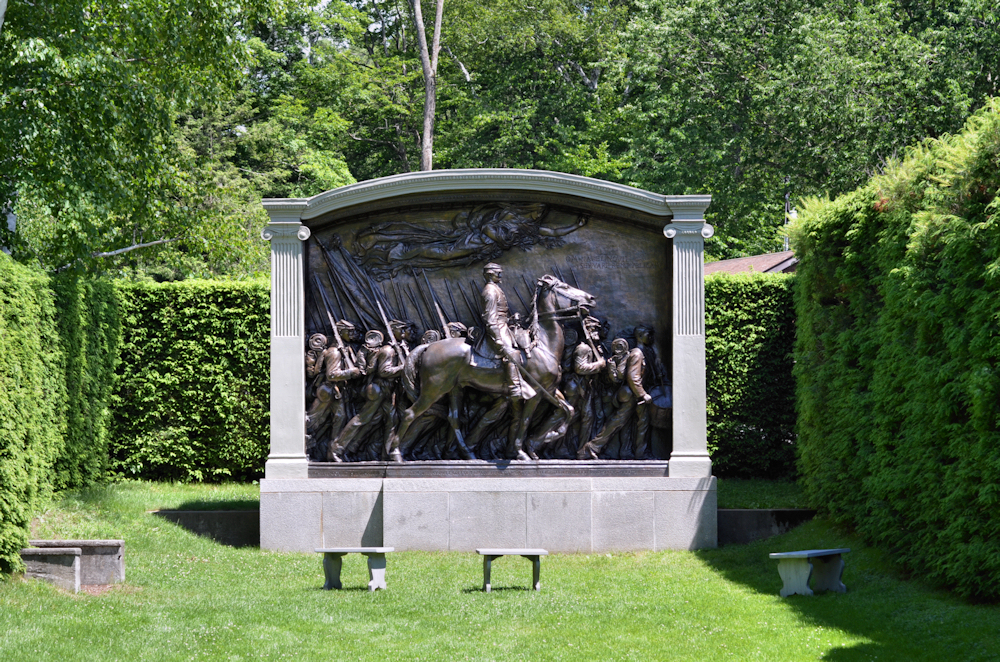
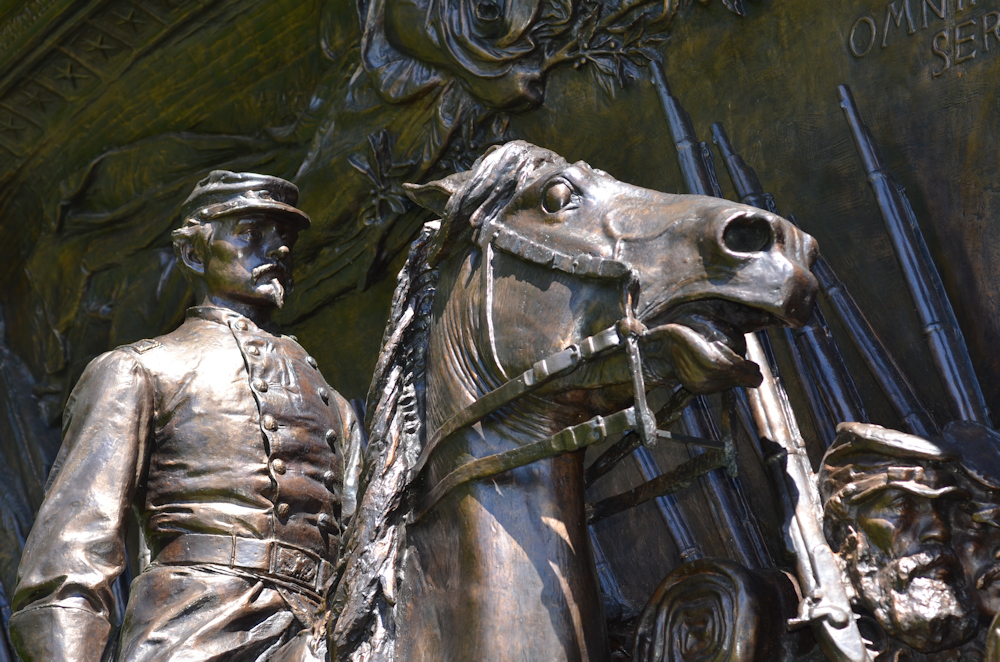
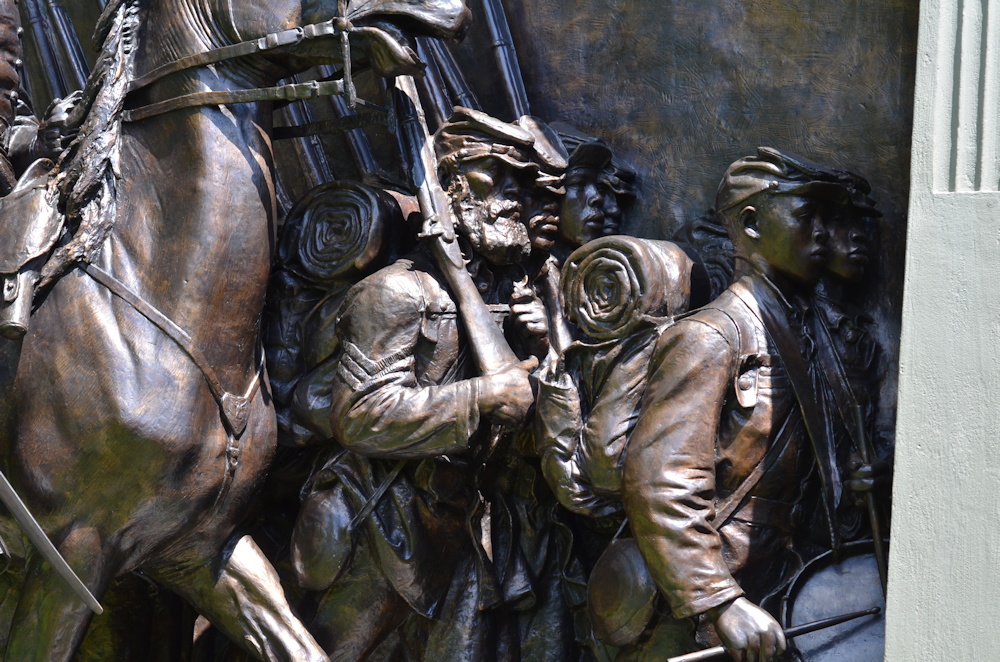

Next to this is a double row of birch trees. This leads to the open air atrium and pool next to a newer gallery. The atrium prominently features Amor Caritas next to a reflecting pool. Tucked away next to the atrium is a small nook with a much larger than life study of Lincoln. I’m 6’4” and this work towered over my head, as does Amor Caritas. Inside the gallery there is a treasure trove for the numismatist. In the past there had been exhibits devoted to the production of the eagle and double eagle as well as the failed attempt at a cent. However, those exhibits are gone and in their place are two tables, about six feet long each, which have several drawers that can be opened to inspect the contents. These contain coins, medals, working plasters, drawings and more. One may open whatever drawers are of interest and can spend quite a while examining the pieces. Also inside the gallery is a study of Victory used in the Shaw Memorial and again, one may go right up to it to get as close as desired. The images may make Victory appear to be a tiny work, but it is really about four or more feet in height.

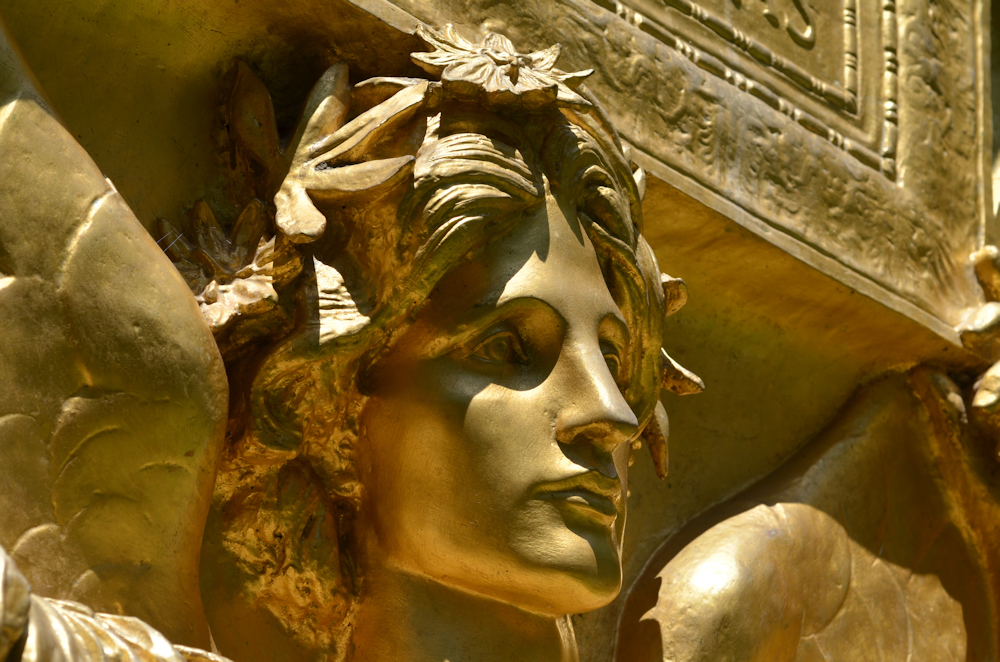
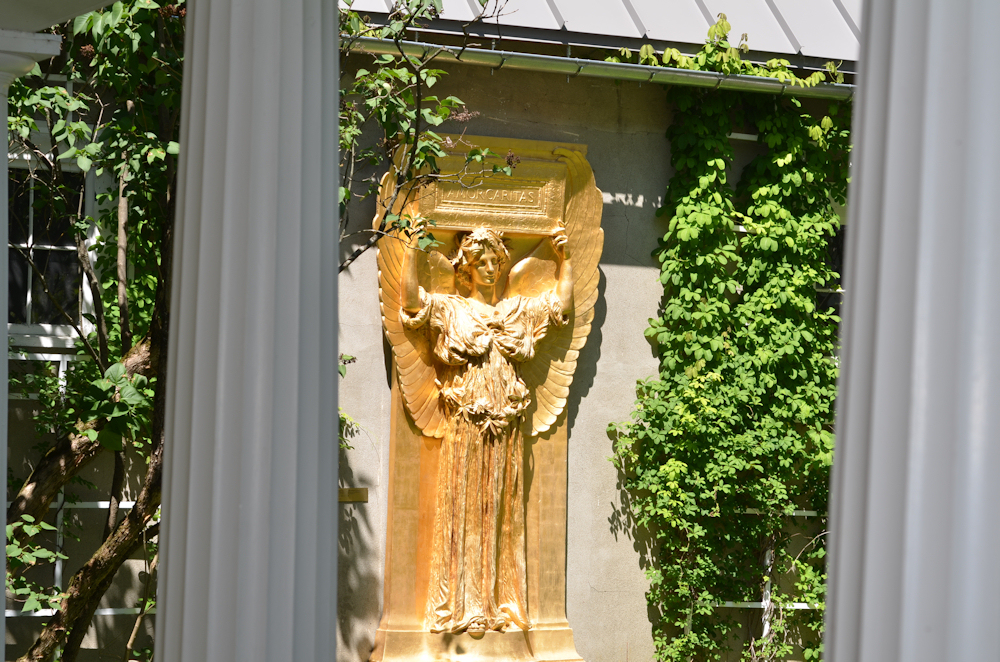
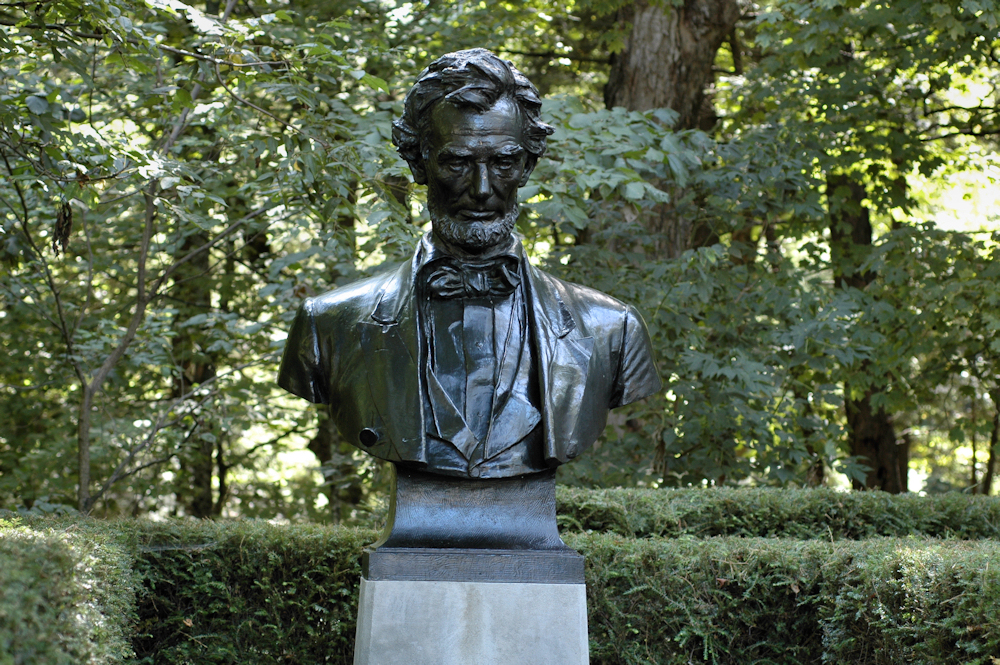
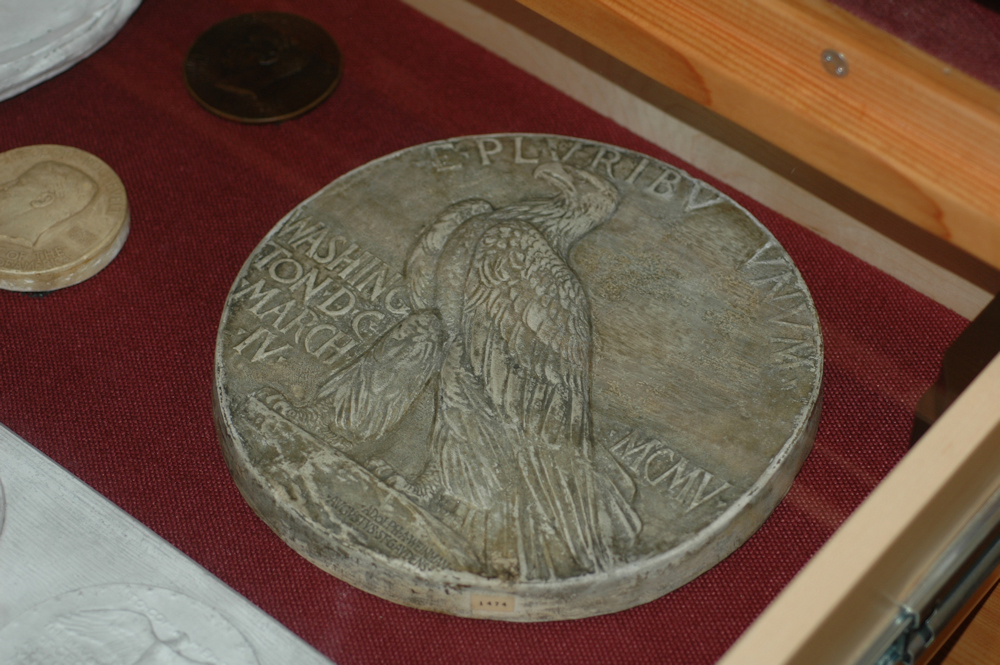
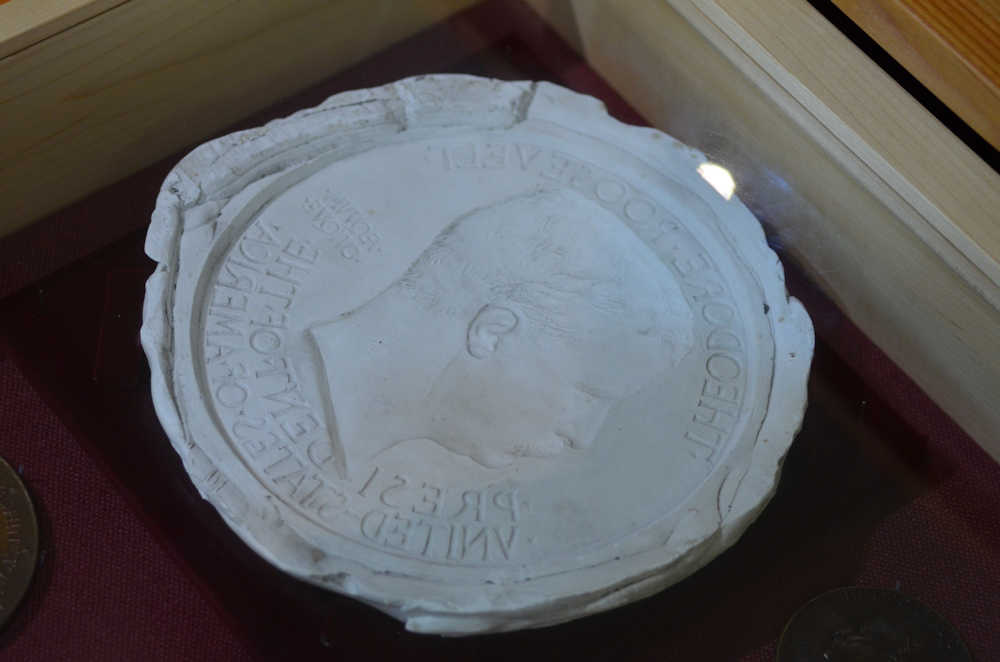
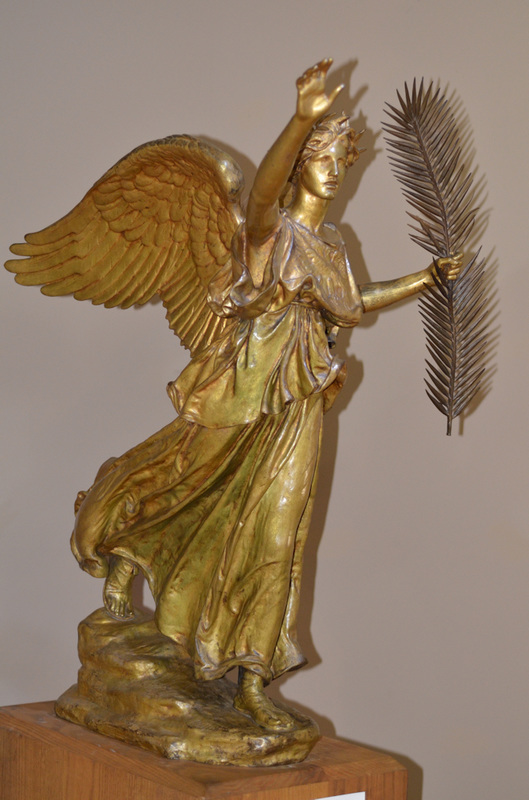
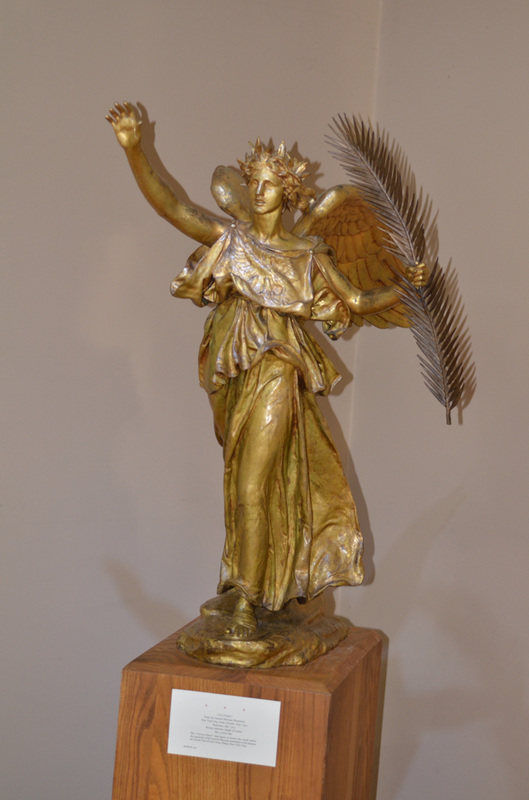
On the opposite side atrium is the Farragut Memorial. This was the first large scale commission that Saint Gaudens had received and it was finished in 1881. The original sandstone base was replaced with marble in 1900 and the original base now sits on display at SGNHS. This is a really large work with Farragut standing taller than the base. We have a series of photos of my daughters over the years sitting on the original sandstone bench and mimicking the poses of the allegorical models. Farragut is best remembered for the Battle of Mobile Bay where he has been stated to have exclaimed “Damn the torpedoes, full speed ahead”. The Farragut Memorial was unlike anything that had been previously seen in the United States and featured the billowing coat of Farragut standing on top of a large sandstone base that served as a bench and had itself been adorned with bas relief models and remarkable lettering. Next to this is a memorial to Henry Maxwell. Again, this stands perhaps seven feet in height. There is a remarkably and refreshingly small gift shop on the premises and even this has works (not for sale) scattered through it.
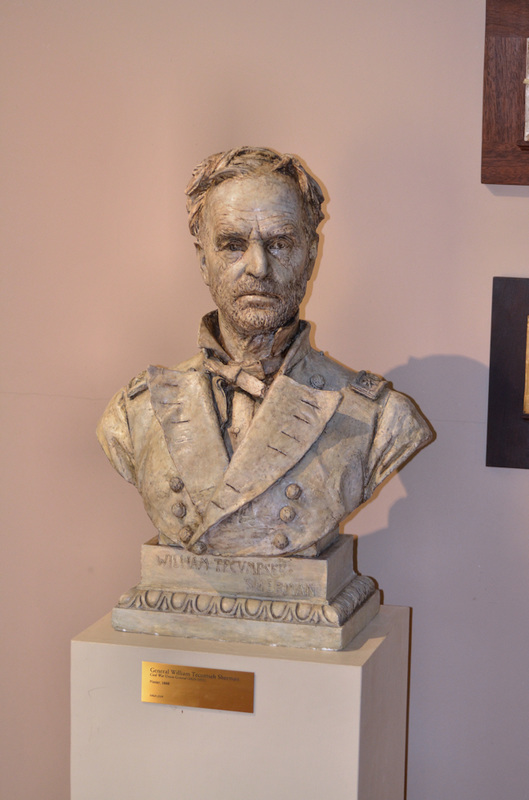


The sun, and temperature, goes down hard and fast around here and by 6:30 in the evening the temperature dropped about 15-degrees within a half-hour. The first of the telescope enthusiasts started to show up for the star party and within moments the grass outside Aspet was dotted with Volkswagen and Subaru hatchbacks such that it looked like a field of colorful sunflowers. Here is our friend Pan with golden sunlight on him along with Mount Ascutney at sunset and the first telescope of the evening.
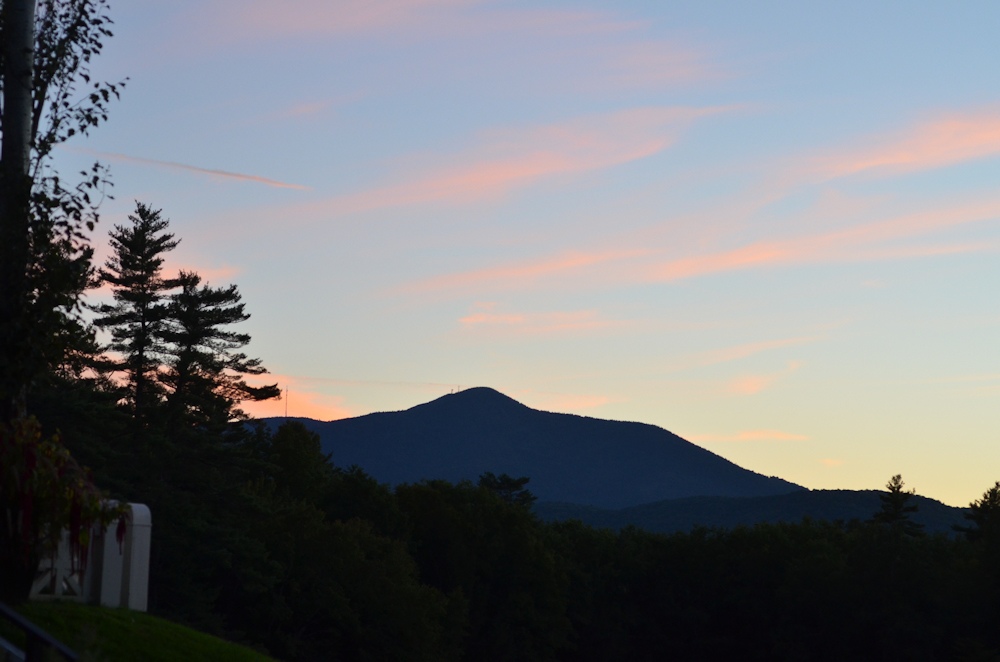
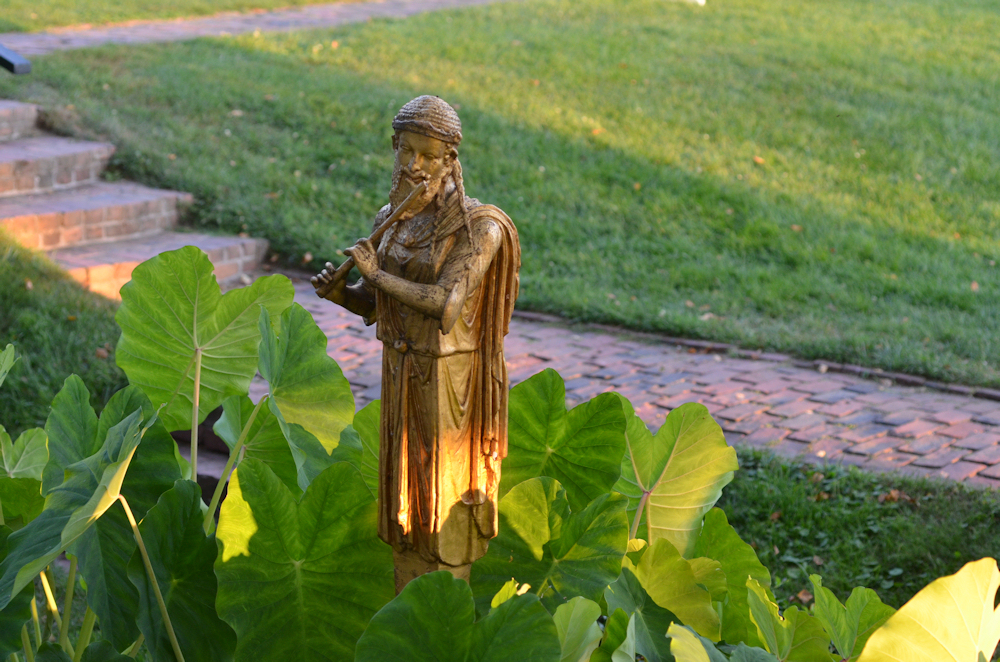

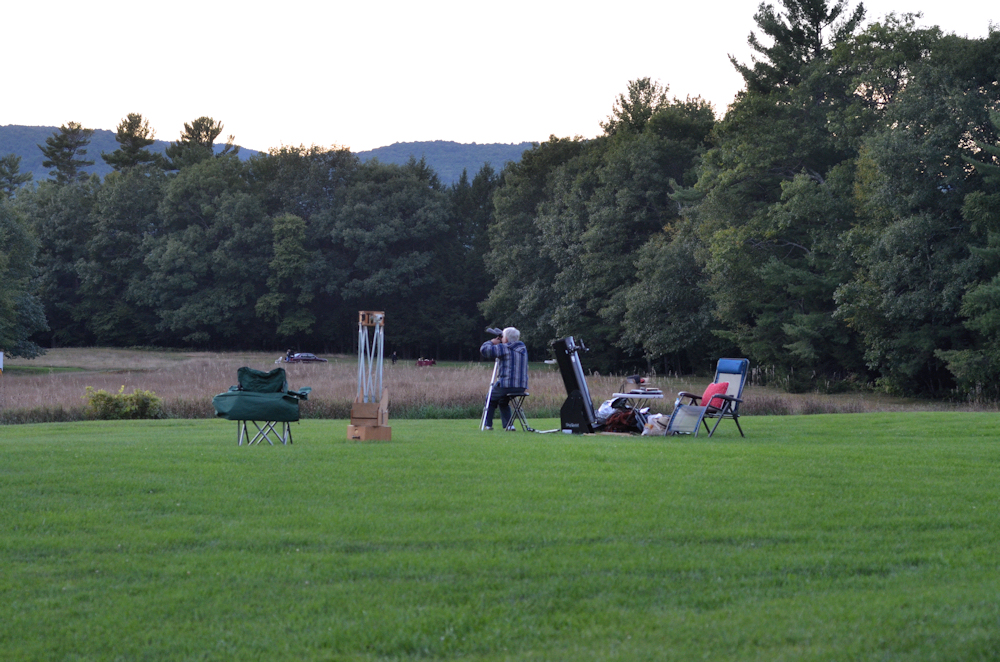
We were here for the star party, which is a fairly new and annual event where the SGNHS is kept open late and where the Stellafane Astronomy Club brings out telescopes to share the night sky with the public. All the lights are turned out and it is quite dark after sunset. We sat on the porch of Aspet watching the sun go down and it reminded me of sitting on my grandparents’ porch listening to old Met games on the radio. We would sit in the dark within the screened-in porch and listen to Bob Murphy, Ralph Kiner and Lindsey Nelson narrate the early 1970s Met games with our hopes pinned on Tom Seaver, Jerry Koosman or Jon Matlack and with our fear being that the perpetually anemic Met offense would have to bail out the pitching. It was easy to sit out in the night air while the sun went down and to listen to the baseball games all summer long; I thought those times and those people would be there forever. Alas, they are all gone and I attempted to describe to my daughters what it was like.
The Park Rangers provided a 20-minute lecture on the sky and the importance of access to dark skies as well as the Dark Sky Initiative. We then headed over to the telescopes, perhaps eight telescopes in total, and looked through while talking to their owners. The owners were like coin people who were happy to discuss what they knew and to educate those who would like to learn. We saw Saturn up close and personal with the rings at an angle that made them easy to discern and also noticed Titan hanging out nearby. It scampered across our field of vision a number of times and had to be tracked down again. Others had their scopes trained on the globular cluster M13 and the Hercules Cluster. These clusters are reminiscent of immunofluorescence of fibroblasts. Perhaps three dozen folks were in attendance this year, which is more than there were last year. However, ours was the only non-New Hampshire, non-Vermont plate in the parking lot.
The Park Service had a great poster for sale featuring the star party, but they didn’t have many and most that they had were somewhat bent. However, I purchased all the pieces that were flat and in good shape and have given one each to my daughters as well as put a few away for friends. I have even framed one for my office and it looks spectacular. There are still a few left piled in my closet. They must be about 10 x 15 inches.
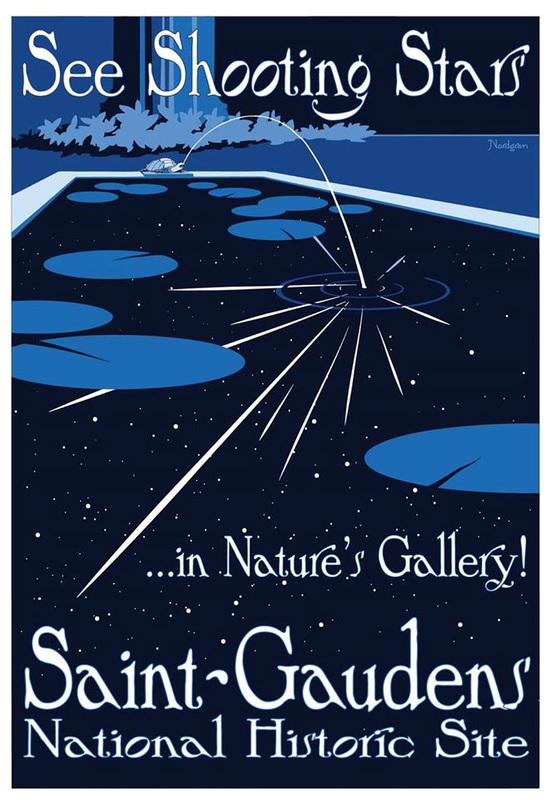
I live close enough to the Saint Gaudens National Historic Site (SGNHS) such that my wife and I have visited several dozen times over the years and we have brought our daughters there numerous times, too. In general, we drive out to the SGHNS at least twice and up to four times during the year.
The site is in Cornish, NH, right along the Maxfield Parish Highway and has only a small sign at the beginning of the 0.6 mile long driveway. The driveway is fairly steep throughout and I imagine that 100+ years ago when the grounds were first built out that it was truly a bear to transport anything up the mountain. The tiny 24-spot parking lot has never been filled during one of our visits and this last weekend ours was the eighth car in the lot when we arrived around noon after a short walking tour of Dartmouth College. Admission to the park has increased in the last year, but at $7.00 per adult and no charge for children it is still a bargain. We have been there so often that we know all the Park Rangers by face as they do us, too, and the Park Ranger on duty gave me a friendly wave and asked if we were there to attend the star party that night. The star party was the precise reason why we were at the park that day and I will write about it shortly.
Across the private drive from the parking lot there is a sign to announce your arrival to the site. Behind this is a circular hedge with steps and directly behind the hedge is the house, which was named Aspet by Augustus Saint Gaudens. Aspet is the name of the town in France where Saint Gaudens father had been born. Next to the house is the studio. Neither is an enormous construction and the studio is likely just a tiny bit smaller than the home. We walked into the studio since the house is meant for guided tours while the studio allows a free flowing walk where you can actually get up next to the artwork and be as close as you like.
If one goes through the hedge and slightly to the left (west) then the views would include the Temple to the northwest, the Little Studio to the north and the home (Aspet) to the northeast. To the southwest is Mount Ascutney.




We ate our lunch on the porch of Aspet before exploring the grounds. What look like grape vines along the top of the porch on Aspet and along the veranda of the Little Studio are, indeed, grape vines and at this time of the year they have large, dark purple grapes. Inside the studio, Diana dominates the central working area. The top of her head stands perhaps ten feet off the ground and several images are included to give a sense of the room and the materials in the room. Diana was the only nude female sculpture that Saint Gaudens produced and it was originally placed at the top of Madison Square Garden in New York City. While there, it was gilded, lit up at night and continuously rotated. The model whose face was used for Diana was also used for Amor Caritas.




The studio is flooded with natural light as well as being filled with various works of art. These include a plaque that describes the little temple behind the studio and a special award presented to Saint Gaudens at the Pan American Exposition in 1901, which was created by Saint Gaudens’ former student, James Earle Fraser. Both the plaque and the award are about four feet in their longest dimension. Just around the corner is a tiny extra room that had been the gift shop in the 1990s, but is now a display of additional works of art. This is the only part of the studio that is roped off and, although I managed to set off the alarm system when I leaned over to take an image once, I did not do so on this trip. However, the Rangers ignored the alarm and, when I later told one that I inadvertently set it off; they told me it happens to them, too. These images show some of the work on display in this tiny area including a work featuring Lincoln, the head of the horse from the Sherman Memorial and a double eagle study with its negative.




As soon as one exits the studio there are a series of small gardens that have statues and pools. These images show some of the works of art as well as the fish in the marble pool of the Pan Garden. Just past this garden there is a small wooded area with the Adams Memorial. This stands about seven feet high.






Many people consider the Adams Memorial to be one of the pinnacle examples of the work of Saint Gaudens. This monument had been commissioned after the suicide of Marian Adams and, truly, I have always found this work to be somewhat disturbing. Others have described it as incredibly contemplative, spiritual or soothing, but my thoughts always run toward the idea that I am interrupting something and have invaded personal space. Indeed, this monument is set away from all the others in its own small hedge enclosure. I never feel at ease when I am in there.
Just a few feet away is a narrow, but much larger hedge enclosed area for the Shaw Memorial. I’ve included four images of the memorial to give a sense of depth and well as an idea about how much detail is present in the work. It is approximately four feet deep. Robert Gould Shaw was the leader of the Fifty-Fourth Massachusetts Regiment, which was the first all-African American volunteer regiment. Saint Gaudens had initially proposed having Shaw as the major character of the memorial with the other soldiers far in the background, but Shaw’s family requested that the rest of the soldiers be given the care and respect that Shaw was to receive. The 1989 film “Glory” was based upon this unit, which was annihilated during the Second Battle of Fort Wagner.




Next to this is a double row of birch trees. This leads to the open air atrium and pool next to a newer gallery. The atrium prominently features Amor Caritas next to a reflecting pool. Tucked away next to the atrium is a small nook with a much larger than life study of Lincoln. I’m 6’4” and this work towered over my head, as does Amor Caritas. Inside the gallery there is a treasure trove for the numismatist. In the past there had been exhibits devoted to the production of the eagle and double eagle as well as the failed attempt at a cent. However, those exhibits are gone and in their place are two tables, about six feet long each, which have several drawers that can be opened to inspect the contents. These contain coins, medals, working plasters, drawings and more. One may open whatever drawers are of interest and can spend quite a while examining the pieces. Also inside the gallery is a study of Victory used in the Shaw Memorial and again, one may go right up to it to get as close as desired. The images may make Victory appear to be a tiny work, but it is really about four or more feet in height.








On the opposite side atrium is the Farragut Memorial. This was the first large scale commission that Saint Gaudens had received and it was finished in 1881. The original sandstone base was replaced with marble in 1900 and the original base now sits on display at SGNHS. This is a really large work with Farragut standing taller than the base. We have a series of photos of my daughters over the years sitting on the original sandstone bench and mimicking the poses of the allegorical models. Farragut is best remembered for the Battle of Mobile Bay where he has been stated to have exclaimed “Damn the torpedoes, full speed ahead”. The Farragut Memorial was unlike anything that had been previously seen in the United States and featured the billowing coat of Farragut standing on top of a large sandstone base that served as a bench and had itself been adorned with bas relief models and remarkable lettering. Next to this is a memorial to Henry Maxwell. Again, this stands perhaps seven feet in height. There is a remarkably and refreshingly small gift shop on the premises and even this has works (not for sale) scattered through it.



The sun, and temperature, goes down hard and fast around here and by 6:30 in the evening the temperature dropped about 15-degrees within a half-hour. The first of the telescope enthusiasts started to show up for the star party and within moments the grass outside Aspet was dotted with Volkswagen and Subaru hatchbacks such that it looked like a field of colorful sunflowers. Here is our friend Pan with golden sunlight on him along with Mount Ascutney at sunset and the first telescope of the evening.




We were here for the star party, which is a fairly new and annual event where the SGNHS is kept open late and where the Stellafane Astronomy Club brings out telescopes to share the night sky with the public. All the lights are turned out and it is quite dark after sunset. We sat on the porch of Aspet watching the sun go down and it reminded me of sitting on my grandparents’ porch listening to old Met games on the radio. We would sit in the dark within the screened-in porch and listen to Bob Murphy, Ralph Kiner and Lindsey Nelson narrate the early 1970s Met games with our hopes pinned on Tom Seaver, Jerry Koosman or Jon Matlack and with our fear being that the perpetually anemic Met offense would have to bail out the pitching. It was easy to sit out in the night air while the sun went down and to listen to the baseball games all summer long; I thought those times and those people would be there forever. Alas, they are all gone and I attempted to describe to my daughters what it was like.
The Park Rangers provided a 20-minute lecture on the sky and the importance of access to dark skies as well as the Dark Sky Initiative. We then headed over to the telescopes, perhaps eight telescopes in total, and looked through while talking to their owners. The owners were like coin people who were happy to discuss what they knew and to educate those who would like to learn. We saw Saturn up close and personal with the rings at an angle that made them easy to discern and also noticed Titan hanging out nearby. It scampered across our field of vision a number of times and had to be tracked down again. Others had their scopes trained on the globular cluster M13 and the Hercules Cluster. These clusters are reminiscent of immunofluorescence of fibroblasts. Perhaps three dozen folks were in attendance this year, which is more than there were last year. However, ours was the only non-New Hampshire, non-Vermont plate in the parking lot.
The Park Service had a great poster for sale featuring the star party, but they didn’t have many and most that they had were somewhat bent. However, I purchased all the pieces that were flat and in good shape and have given one each to my daughters as well as put a few away for friends. I have even framed one for my office and it looks spectacular. There are still a few left piled in my closet. They must be about 10 x 15 inches.

0
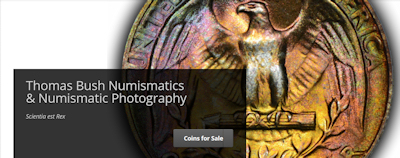
Comments
BST transactions: dbldie55, jayPem, 78saen, UltraHighRelief, nibanny, liefgold, FallGuy, lkeigwin, mbogoman, Sandman70gt, keets, joeykoins, ianrussell (@GC), EagleEye, ThePennyLady, GRANDAM, Ilikecolor, Gluggo, okiedude, Voyageur, LJenkins11, fastfreddie, ms70, pursuitofliberty, ZoidMeister,Coin Finder, GotTheBug, edwardjulio, Coinnmore, Nickpatton, Namvet69,...
It's fun to look at the Glory of the heavens...
U.S. Type Set
I remember seeing a previous post about this site. It is a beautiful place.
Truly a great artist.
It really made me think about all those hours I whiled away on my grandparents porch.
Those were much simpler days.
I have been in my current home for 16 years and there has never even been a chair on the porch.
That is until this past weekend when my dad drug a rocking chair out there and watched me cut grass for a while.
I think I'll go home today and hide my sons Nintendo. Then I'll drag a few chairs out on the porch.
Thanks for the post!
<< <i>You (or maybe someone else) posted about the Saint Gaudens Museum a couple of years ago. I intended to see it them, but it slipped my mind. I will be in the area at the end of the month and again plan to see it. I am looking forward to the experience. Thanks for the reminder. >>
That would be a post by me. Every two or three years I write a new thread about this site because it is so potentially interesting to folks in our hobby-industry. Also, with the advent of the star party, there is even more reason to get up there.
In honor of the memory of Cpl. Michael E. Thompson
My Ebay Store
<< <i>You (or maybe someone else) posted about the Saint Gaudens Museum a couple of years ago. I intended to see it them, but it slipped my mind. I will be in the area at the end of the month and again plan to see it. I am looking forward to the experience. Thanks for the reminder. >>
I posted this last fall (trip made in July 2014).
Whole Lotta Saints
Keeper of the VAM Catalog • Professional Coin Imaging • Prime Number Set • World Coins in Early America • British Trade Dollars • Variety Attribution
<< <i>What a beautiful place. Thanks very much. >>
Thanks, Tom!
Sometimes, it’s better to be LUCKY than good. 🍀 🍺👍
My Full Walker Registry Set (1916-1947):
https://www.ngccoin.com/registry/competitive-sets/16292/
Love the Star party
Successful BST deals with mustangt and jesbroken. Now EVERYTHING is for sale.
I'd love to visit someday.
Click on this link to see my ebay listings.
Pmac
I wish I had visited this site when I lived in New England.
I didn't know that there were two copies of the Shaw Memorial, this one and the well known one that is across from the Massachusetts State Capital in Boston. I have read that there were some complaints because it took St. Gaudens so long to complete the molds for this piece.
If you enjoy seeing the works of sculptors, you might enjoy the Cyrus Dallin museum in Arlington, Massachusetts. Dallin designed the Pilgrim commem but was more famous for Native American themes in his works. He did the large statue of the Indian rider in front of the Museum of fine arts and the large Paul Revere statue on the Freedom Trail in Boston. He's also my first cousin, four times removed.
The astronomy connection is fun too. Once you've seen Saturn's rings in your own telescope you sort of "own" her. I just loved showing my teenage daughters and getting the "Oh, wow!"
That poster is super cool.